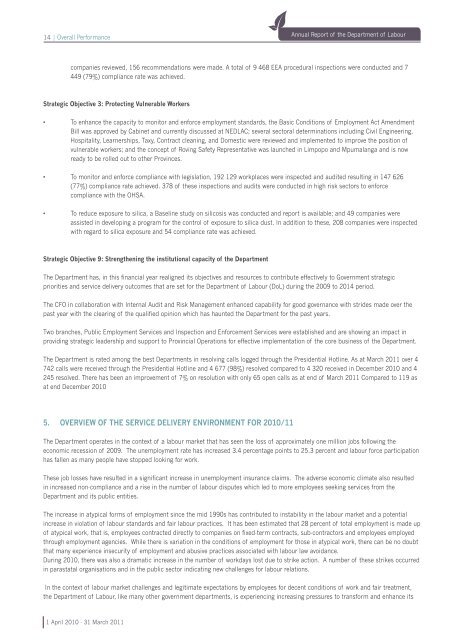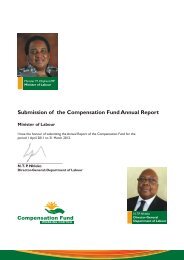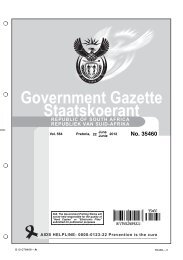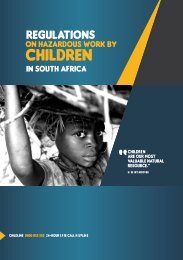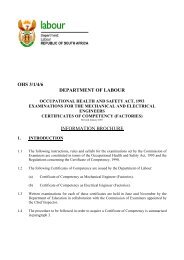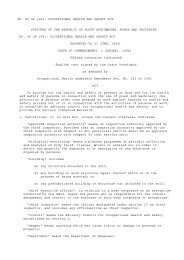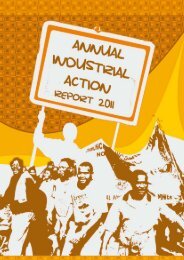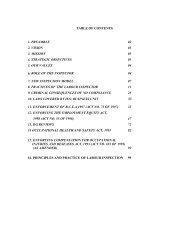Annual Report - Department of Labour 2011- part 2 .pdf
Annual Report - Department of Labour 2011- part 2 .pdf
Annual Report - Department of Labour 2011- part 2 .pdf
- No tags were found...
You also want an ePaper? Increase the reach of your titles
YUMPU automatically turns print PDFs into web optimized ePapers that Google loves.
14 | Overall Performance<strong>Annual</strong> <strong>Report</strong> <strong>of</strong> the <strong>De<strong>part</strong>ment</strong> <strong>of</strong> <strong>Labour</strong>companies reviewed, 156 recommendations were made. A total <strong>of</strong> 9 468 EEA procedural inspections were conducted and 7449 (79%) compliance rate was achieved.Strategic Objective 3: Protecting Vulnerable Workers• To enhance the capacity to monitor and enforce employment standards, the Basic Conditions <strong>of</strong> Employment Act AmendmentBill was approved by Cabinet and currently discussed at NEDLAC; several sectoral determinations including Civil Engineering,Hospitality, Learnerships, Taxy, Contract cleaning, and Domestic were reviewed and implemented to improve the position <strong>of</strong>vulnerable workers; and the concept <strong>of</strong> Roving Safety Representative was launched in Limpopo and Mpumalanga and is nowready to be rolled out to other Provinces.• To monitor and enforce compliance with legislation, 192 129 workplaces were inspected and audited resulting in 147 626(77%) compliance rate achieved. 378 <strong>of</strong> these inspections and audits were conducted in high risk sectors to enforcecompliance with the OHSA.• To reduce exposure to silica, a Baseline study on silicosis was conducted and report is available; and 49 companies wereassisted in developing a program for the control <strong>of</strong> exposure to silica dust. In addition to these, 208 companies were inspectedwith regard to silica exposure and 54 compliance rate was achieved.Strategic Objective 9: Strengthening the institutional capacity <strong>of</strong> the <strong>De<strong>part</strong>ment</strong>The <strong>De<strong>part</strong>ment</strong> has, in this financial year realigned its objectives and resources to contribute effectively to Government strategicpriorities and service delivery outcomes that are set for the <strong>De<strong>part</strong>ment</strong> <strong>of</strong> <strong>Labour</strong> (DoL) during the 2009 to 2014 period.The CFO in collaboration with Internal Audit and Risk Management enhanced capability for good governance with strides made over thepast year with the clearing <strong>of</strong> the qualified opinion which has haunted the <strong>De<strong>part</strong>ment</strong> for the past years.Two branches, Public Employment Services and Inspection and Enforcement Services were established and are showing an impact inproviding strategic leadership and support to Provincial Operations for effective implementation <strong>of</strong> the core business <strong>of</strong> the <strong>De<strong>part</strong>ment</strong>.The <strong>De<strong>part</strong>ment</strong> is rated among the best <strong>De<strong>part</strong>ment</strong>s in resolving calls logged through the Presidential Hotline. As at March <strong>2011</strong> over 4742 calls were received through the Presidential Hotline and 4 677 (98%) resolved compared to 4 320 received in December 2010 and 4245 resolved. There has been an improvement <strong>of</strong> 7% on resolution with only 65 open calls as at end <strong>of</strong> March <strong>2011</strong> Compared to 119 asat end December 20105. OVERVIEW OF THE SERVICE DELIVERY ENVIRONMENT FOR 2010/11The <strong>De<strong>part</strong>ment</strong> operates in the context <strong>of</strong> a labour market that has seen the loss <strong>of</strong> approximately one million jobs following theeconomic recession <strong>of</strong> 2009. The unemployment rate has increased 3.4 percentage points to 25.3 percent and labour force <strong>part</strong>icipationhas fallen as many people have stopped looking for work.These job losses have resulted in a significant increase in unemployment insurance claims. The adverse economic climate also resultedin increased non-compliance and a rise in the number <strong>of</strong> labour disputes which led to more employees seeking services from the<strong>De<strong>part</strong>ment</strong> and its public entities.The increase in atypical forms <strong>of</strong> employment since the mid 1990s has contributed to instability in the labour market and a potentialincrease in violation <strong>of</strong> labour standards and fair labour practices. It has been estimated that 28 percent <strong>of</strong> total employment is made up<strong>of</strong> atypical work, that is, employees contracted directly to companies on fixed-term contracts, sub-contractors and employees employedthrough employment agencies. While there is variation in the conditions <strong>of</strong> employment for those in atypical work, there can be no doubtthat many experience insecurity <strong>of</strong> employment and abusive practices associated with labour law avoidance.During 2010, there was also a dramatic increase in the number <strong>of</strong> workdays lost due to strike action. A number <strong>of</strong> these strikes occurredin parastatal organisations and in the public sector indicating new challenges for labour relations.In the context <strong>of</strong> labour market challenges and legitimate expectations by employees for decent conditions <strong>of</strong> work and fair treatment,the <strong>De<strong>part</strong>ment</strong> <strong>of</strong> <strong>Labour</strong>, like many other government de<strong>part</strong>ments, is experiencing increasing pressures to transform and enhance its1 April 2010 - 31 March <strong>2011</strong>


